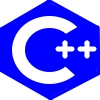Bit field
C++ Bit Fields
Bit fields in C++ are a feature that allows struct members to be allocated with a specific number of bits, which helps in optimizing memory usage, particularly in low-level programming.
Definition and Syntax
A bit field is declared inside a `struct` or `union`, specifying the number of bits each member should occupy. The syntax is:
Each field's bit width is defined using `:` followed by the number of bits. These fields are stored compactly in memory, reducing overall size.
Memory Layout
Bit fields are packed within the underlying storage unit (usually an `int`). However, the compiler may introduce padding for alignment purposes. Consider the following example:
<syntaxhighlight lang="cpp"> struct Packed {
unsigned char x : 4; unsigned char y : 4; unsigned char z : 8;
}; </syntaxhighlight>
Even though `x` and `y` together use 8 bits, and `z` also uses 8 bits, the compiler may store them within a 16-bit unit.
Signed vs. Unsigned Bit Fields
By default, if no `signed` or `unsigned` keyword is used, the signedness is implementation-defined. To ensure behavior:
<syntaxhighlight lang="cpp"> struct SignedExample {
signed int a : 4; // Explicitly signed unsigned int b : 4; // Explicitly unsigned
}; </syntaxhighlight>
Negative values in signed bit fields use two’s complement representation.
Bit Field Operations
Bit fields can be assigned values just like normal integer members but must respect the bit width:
<syntaxhighlight lang="cpp"> Example e; e.a = 5; // Allowed (fits within 3 bits: 0-7) e.b = 25; // Allowed (fits within 5 bits: 0-31) e.c = 3; // Out of range! Undefined behavior. </syntaxhighlight>
Accessing Bit Fields
Bit fields are accessed like regular struct members:
<syntaxhighlight lang="cpp">
- include <iostream>
struct Flags {
unsigned int flag1 : 1; unsigned int flag2 : 1; unsigned int flag3 : 1;
};
int main() {
Flags f = {1, 0, 1};
std::cout << "Flag1: " << f.flag1 << "\n";
std::cout << "Flag2: " << f.flag2 << "\n";
std::cout << "Flag3: " << f.flag3 << "\n";
return 0;
} </syntaxhighlight>
Limitations of Bit Fields
1. **No Addressability:** You cannot take the address of a bit field.
<syntaxhighlight lang="cpp"> Flags f; unsigned int* ptr = &f.flag1; // Error! </syntaxhighlight>
2. **Performance Overhead:** Accessing bit fields may generate extra instructions due to masking and shifting.
3. **Portability Issues:** Bit field layout and padding depend on the compiler and platform.
Alternative: Bit Manipulation with Masks
When precise control is needed, direct bitwise operations are often preferred:
<syntaxhighlight lang="cpp">
- define FLAG1 (1 << 0)
- define FLAG2 (1 << 1)
- define FLAG3 (1 << 2)
unsigned int flags = 0; flags |= FLAG1; // Set flag1 if (flags & FLAG2) { /* Check flag2 */ } flags &= ~FLAG3; // Clear flag3 </syntaxhighlight>
Conclusion
Bit fields are useful for memory-efficient structures, especially in embedded systems, hardware interfacing, and low-level programming. However, they come with limitations such as undefined layout across different compilers and inability to take addresses of bit fields. In cases where flexibility is needed, manual bitwise operations using masks may be a better choice.
